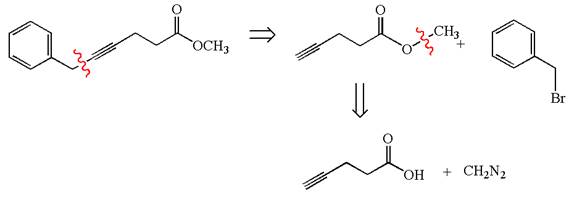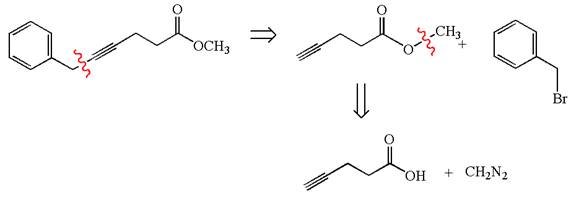
(a)
Interpretation:
It is to be shown how a retrosynthetic analysis might be constructed for the given synthesis.
Concept introduction:
Retrosynthesis is the planning of
Answer to Problem 13.30P
The retrosynthesis for the given synthesis is

Explanation of Solution
The given synthetic reaction is

In the given synthesis, the product differs from the starting compound by one ethyl group bonded to six-membered ring. Thus, the bond between the ethyl group and ring carbon in the target must break to transform it to the starting compound.
Therefore, retrosynthesis for the given synthetic reaction is

The retrosynthesis for the given synthetic reaction is shown by disconnecting the ethyl group from the ring.
(b)
Interpretation:
It is to be shown how a retrosynthetic analysis might be constructed for the given synthesis.
Concept introduction:
Retrosynthesis is the planning of organic synthesis, working backwards from target molecule to a simpler precursor, regardless of any interaction with reagents. Thus, the basis of retrosynthetic analysis is the transform, which means the reverse of a synthetic reaction. The precursors are the compounds, which are either readily available or easy to produce. The transform is indicated by an open arrow
Answer to Problem 13.30P
The retrosynthesis for the given synthesis is

Explanation of Solution
The given synthetic reaction is

The given synthesis is of two steps; the final product is the target molecule. Thus, retrosynthesis could be planned from the target to the intermediate product to the starting material. The target molecule and the intermediate product differ in bromine and cyanide. Thus, the bond between the cyanide and ring carbon must break to transform into an intermediate. The intermediate and the starting molecule differ by bromine atom. Thus, the bond between the bromine and ring carbon must break to transform into the starting material.
Therefore, the retrosynthesis for the given synthetic reaction is

The retrosynthesis for the given synthetic reaction is shown by disconnecting the cyanide group and then by disconnecting the bromine atom from the ring.
(c)
Interpretation:
It is to be shown how a retrosynthetic analysis might be constructed for the given synthesis.
Concept introduction:
Retrosynthesis is the planning of organic synthesis, working backwards from target molecule to a simpler precursor, regardless of any interaction with reagents. Thus, the basis of retrosynthetic analysis is the transform, which means the reverse of a synthetic reaction. The precursors are the compounds, which are either readily available or easy to produce. The transform is indicated by an open arrow
Answer to Problem 13.30P
The retrosynthesis for the given synthesis is

Explanation of Solution
The given synthetic reaction is

The given synthesis is of two steps; the final product is the target molecule. Thu, s the retrosynthesis could be planned from the target to the intermediate product to the starting material. The target molecule and the intermediate product differ in the benzyl group attached to the triple bonded carbon. Thus, the bond between the benzylic carbon and triple bonded carbon must break to transform into an intermediate. The intermediate can be transformed into the starting material by replacing the methyl group bonded to the oxygen atom by hydrogen.
Therefore, the retrosynthesis for the given synthetic reaction is

The retrosynthesis for the given synthetic reaction is shown by disconnecting the benzyl group from the triple bonded carbon and then by disconnecting the methyl group from the oxygen atom.
(d)
Interpretation:
It is to be shown how a retrosynthetic analysis might be constructed for the given synthesis.
Concept introduction:
Retrosynthesis is the planning of organic synthesis, working backwards from target molecule to a simpler precursor, regardless of any interaction with reagents. Thus, the basis of retrosynthetic analysis is the transform, which means the reverse of a synthetic reaction. The precursors are the compounds, which are either readily available or easy to produce. The transform is indicated by an open arrow
Answer to Problem 13.30P
The retrosynthesis for the given synthesis is

Explanation of Solution
The given synthetic reaction is

The given synthesis is of two steps; the final product is the target molecule. Thus the retrosynthesis could be planned from the target to the intermediate product to the starting material. The target molecule has a double bond, which is removed in the intermediate product having the ydroxyl group at that position. Thus, the
Therefore, the retrosynthesis for the given synthetic reaction is

The retrosynthesis for the given synthetic reaction is shown by disconnecting the
(e)
Interpretation:
It is to be shown how a retrosynthetic analysis might be constructed for the given synthesis.
Concept introduction:
Retrosynthesis is the planning of organic synthesis, working backwards from target molecule to a simpler precursor, regardless of any interaction with reagents. Thus, the basis of retrosynthetic analysis is the transform, which means the reverse of a synthetic reaction. The precursors are the compounds, which are either readily available or easy to produce. The transform is indicated by an open arrow
Answer to Problem 13.30P
The retrosynthesis for the given synthesis is

Explanation of Solution
The given synthetic reaction is

The given synthesis is of three steps; the final product is the target molecule. Thus, the retrosynthesis could be planned from the target to the second intermediate, then to the first intermediate, and finally into the starting material. The target molecule has the acetate group at the alpha position and the second intermediate has the bromine atom; thus, the bond between the alpha carbon and the oxygen of the acetate group must break. The second intermediate can be transformed into the first intermediate by breaking the bond between bromine and the alpha carbon. The first intermediate and the starting molecule differ by an additional methyl group; thus the bond between the alpha carbon and methyl must break to show the transform.
Therefore, the retrosynthesis for the given synthetic reaction is

The retrosynthesis for the given synthetic reaction is shown by disconnecting appropriate bonds.
(g)
Interpretation:
It is to be shown how a retrosynthetic analysis might be constructed for the given synthesis.
Concept introduction:
Retrosynthesis is the planning of organic synthesis, working backwards from target molecule to a simpler precursor, regardless of any interaction with reagents. Thus, the basis of retrosynthetic analysis is the transform, which means the reverse of a synthetic reaction. The precursors are the compounds, which are either readily available or easy to produce. The transform is indicated by an open arrow
Answer to Problem 13.30P
The retrosynthesis for the given synthesis is

Explanation of Solution
The given synthetic reaction is

The given synthesis is of three steps; the final product is the target molecule. Thus; the retrosynthesis could be planned from the target to the second intermediate; then to the first intermediate; and finally into the starting material. The target can be transformed to the second intermediate by replacing the nitride group by bromine; thus the bond between the nitride group and carbon must break. The second intermediate can be transformed into the first intermediate by replacing the bromine by hydroxyl group; thus the bond between bromine and carbon must break. The first intermediate can be transformed into the starting material by replacing the hydroxyl group by ethoxy group.
Therefore, the retrosynthesis for the given synthetic reaction is

The retrosynthesis for the given synthetic reaction is shown by disconnecting appropriate bonds.
Want to see more full solutions like this?
Chapter 13 Solutions
Organic Chemistry: Principles And Mechanisms
- V Biological Macromolecules Drawing the Haworth projection of an aldose from its Fischer projection Draw a Haworth projection of a common cyclic form of this monosaccharide: H C=O HO H HO H H OH CH₂OH Explanation Check Click and drag to start drawing a structure. Xarrow_forwardComplete the mechanismarrow_forwardComplete the mechanismarrow_forward
- 8 00 6 = 10 10 Decide whether each of the molecules in the table below is stable, in the exact form in which it is drawn, at pH = 11. If you decide at least one molecule is not stable, then redraw one of the unstable molecules in its stable form below the table. (If more than unstable, you can pick any of them to redraw.) Check OH stable HO stable Ounstable unstable O OH stable unstable OH 80 F6 F5 stable Ounstable X Save For Later Sub 2025 McGraw Hill LLC. All Rights Reserved. Terms of Use | Privacy C ཀྭ་ A F7 매 F8 F9 4 F10arrow_forwardJust try completing it and it should be straightforward according to the professor and TAs.arrow_forwardThe grading is not on correctness, so if you can just get to the correct answers without perfectionism that would be great. They care about the steps and reasoning and that you did something. I asked for an extension, but was denied the extension.arrow_forward
 Organic ChemistryChemistryISBN:9781305580350Author:William H. Brown, Brent L. Iverson, Eric Anslyn, Christopher S. FootePublisher:Cengage Learning
Organic ChemistryChemistryISBN:9781305580350Author:William H. Brown, Brent L. Iverson, Eric Anslyn, Christopher S. FootePublisher:Cengage Learning
